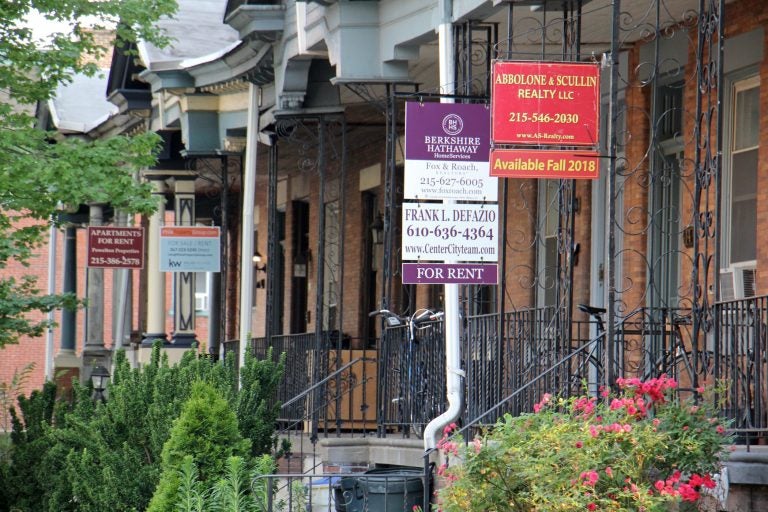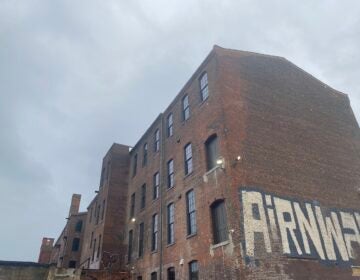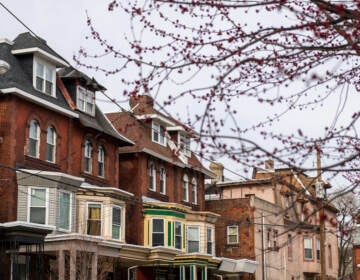New map shows Philly renter spike sharper than other big cities
Over the last decade, Philadelphia saw a rise in rentership well above the national average, and higher than most of the nation’s other large cities, according to new data

Rowhomes at 34th and Spring Garden Street for sale or rent. (Emma Lee/WHYY)
This story originally appeared on PlanPhilly.
—
Over the last decade, Philadelphia saw a rise in rentership well above the national average, and higher than most of the nation’s other large cities, according to new data released Tuesday by APM Research Lab and Marketplace.
The percent of Philly households renting shot up by more than 6 points between 2006 and 2016, to 47.9 percent. That jump was bigger than the national increase of 4.2 percent, and the third largest among the nation’s 10 most populous cities.
Behind the trend both locally and nationally, experts see the Great Recession. When the housing bubble burst, a lot of homeowners lost their houses to foreclosure, while young people entered the workforce into the worst economic downturn since the 1930s.
“[Those trends combined] lead to a shift from owning to renting, or at least delayed ownership for many households,” said Kevin Gillen, senior research fellow at Drexel University’s Lindy Institute for Urban Innovation. “In response to that increase in demand for renting, Philadelphia and many other cities went through a significant expansionary cycle that added to the rental housing stock.”
That trend seems to have peaked in 2013 when the renter rate stood at 49 percent. That was followed by two years of slight increases in homeownership, before renting inched up in popularity again in 2016.
Gillen said that rents in Philadelphia have recently gone slack as a lot of new rental housing units have come online and some younger households have begun to transition to homeownership. But that hasn’t resulted in significant rent declines, at least not yet.
“The value of any apartment building is directly related to the rental income it throws off,” said Gillen. “So the last thing owners or landlords will do in a softening market is drop rents. Instead, they’ll offer tenant concessions, give you two months free rent, six months of free parking, or something else that won’t directly show up in the financials of the property itself.”
This kind of competition for renters is concentrated in the upper-income brackets. For many Philadelphians, the benefit they’ll see is from what economists call “filtering,” wherein wealthier renters move into those new units and leave behind older and cheaper units for those with slightly lower incomes and so on.
But while that process is an important aspect of maintaining housing affordability in the medium-to-long term, it doesn’t do as much for many renters in the short term. That’s especially true in neighborhoods where older units are being rehabbed and rented for higher prices, in a kind of reverse filtering. The lowest income renters, in particular, often cannot rely on the market for safe and stable housing.
“The increase of renters means there are larger constituencies for our elected officials to listen to the needs of renters and increase renter protections across the city,” said Emily Auerbach, communications director for the Philadelphia Tenants Union. “Because currently, the law is just not strong enough, most of the time, to protect people.”
Philadelphia policymakers have enacted a number of policies to protect low-income homeowners from property tax increases and other costs that could push them out of appreciating neighborhoods. But renters do not enjoy such protections from displacement. A recent study from the Pew Charitable Trusts found that four out of five low-income Philly renters receive no housing aid, even higher than the national rate. Philadelphia’s eviction rate is cripplingly high, particularly in African-American neighborhoods, and renters are usually at a serious disadvantage when they go to housing court.
Philadelphia’s proposed Housing Action Plan features a number of ideas for aiding poor renters. These include a shallow municipal rent voucher to aid those at risk of homelessness, beefed-up tenant aid in eviction court, and services designed to get homeless families under a roof. But it is not clear how exactly these programs will be funded. The recent compromise between Mayor Jim Kenney and City Council, projected to bring in $71 million for affordable housing over the next five years, includes a policy change allowing funds to used to aid middle-income households as well as the low-income families that have historically been served by the city’s affordable housing trust fund.
The Tenants Union also wants to see movement on City Councilman Curtis Jones’ Just Cause eviction bill, introduced one year ago. (His staff said recently that they believe the bill will pass by the end of this session, although they said the same thing during the spring session.) The Tenants Union is additionally hoping for increased enforcement of the Housing Code by the Department of Licenses and Inspections, which they feel hasn’t done enough to crack down on landlords who don’t keep their units in proper repair or who illegally refuse to take Housing Choice Vouchers.
A recent Urban Institute study found that 67 percent of Philadelphia landlords won’t accept tenants bearing housing choice vouchers.
“It’d be great if there were more money for [renter aid] in eviction court but it’d be even better if no one had to go to eviction court,” said Auerbach. “Instead the city could put more effort into creating affordable housing and an increased rate of landlords accepting housing choice vouchers.”
Gillen said that as the rental market tightens, more landlords will feel the pressure to accept vouchers. The larger takeaway from the Marketplace data, he said, is that Philadelphia, despite its poverty and the hit it took in the Great Recession, remains a city of homeowners.
“We still have one of the highest poverty rates of any large city in America and have seen large increases in rentership,” said Gillen. “The fact that we still remain a majority homeownership city, despite these two things that would seem to work against homeownership, tells you how much more structurally stable our housing market is despite whatever dramatic swings there might be in the short run.”
WHYY is your source for fact-based, in-depth journalism and information. As a nonprofit organization, we rely on financial support from readers like you. Please give today.







